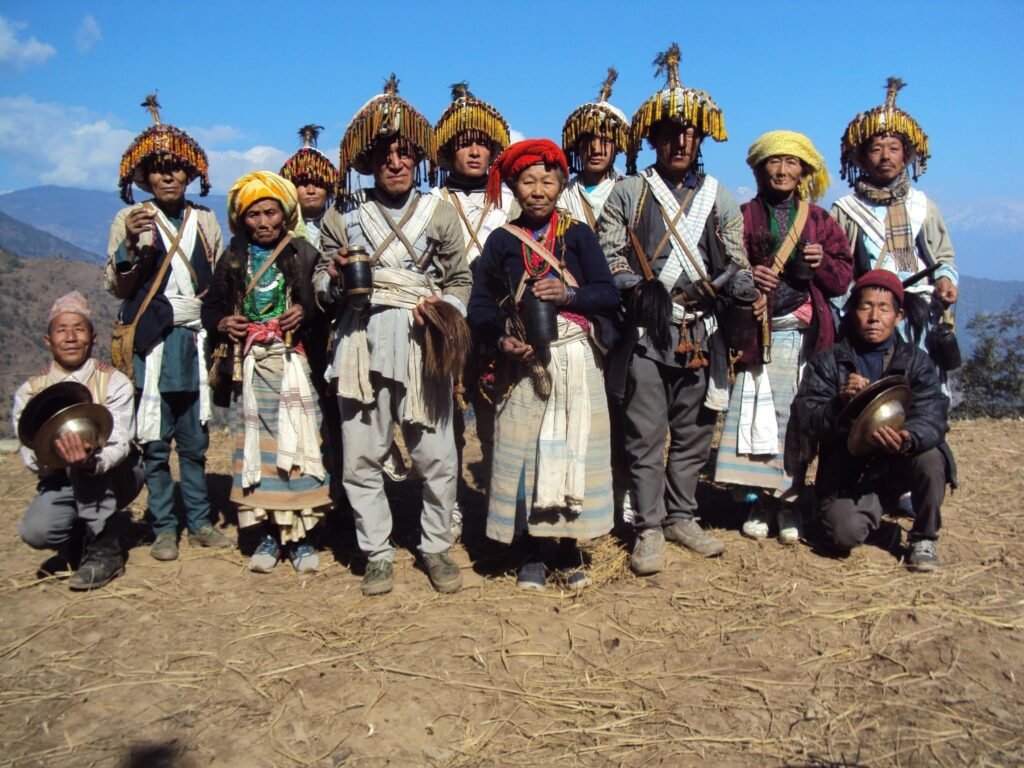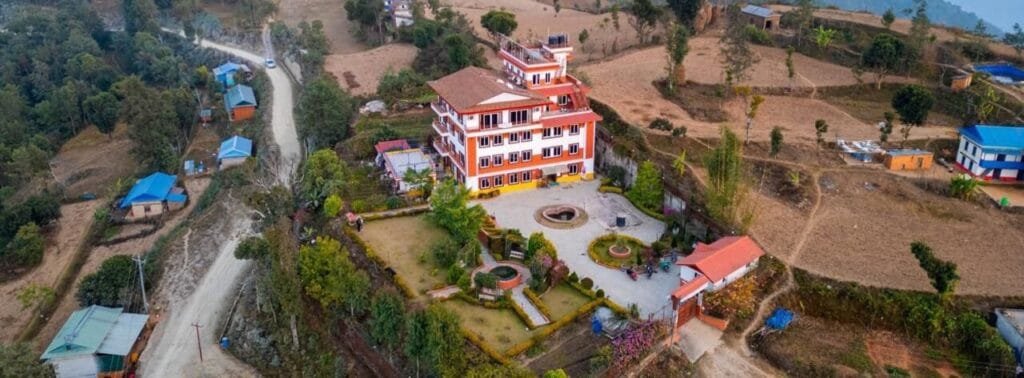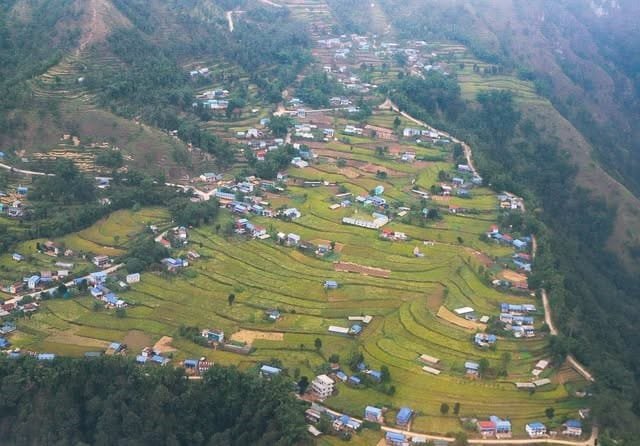Okhaldhunga, Nepal, is a microcosm of how tradition and modern aspiration can flourish, from its breathtaking landscapes to its resilient people. This comprehensive article—delves into every facet of the Okhaldhunga district, illuminating its history, heritage, local economy, tourism potential, and a path toward sustainable growth. Whether you’re a traveler seeking adventure, a student researching local governance, or a development enthusiast looking for ways to contribute, this in-depth guide has everything you need to know about Okhaldhunga.
Table of Contents
Highlights
| Key Attribute | Details |
| Location | Okhaldhunga, situated in eastern Nepal, distinguished by its rugged terrain, fertile valleys, and scenic natural beauty. |
| Population & Demographics | A steadily growing, diverse population rooted in ethnic, linguistic, and cultural variety; fosters a strong sense of community. |
| History & Politics | Deep historical ties shaped by ancient trade routes and evolving local governance. Modern politics emphasize grassroots participation and decentralized decision-making in Okhaldhunga district. |
| Economy & Development | Predominantly agricultural economy; small industries and local entrepreneurship on the rise. Microfinance, education, and infrastructure improvements are key growth drivers. |
| Culture & Society | Vibrant traditional customs, music, festivals, and an amalgam of modern influences; underpinned by communal values and a rich cultural identity known widely as Okhaldhunga culture. |
| Tourism & Attractions | Rapidly emerging sector featuring scenic treks, cultural festivals, local cuisine, and hospitable accommodations. Okhaldhunga tourism is enhanced by new roads, better lodging, and a growing push for sustainable development. |
| Public Services | Expanding network of roads, healthcare (including Okhaldhunga hospital), educational facilities, and future plans for an Okhaldhunga airport, reflecting the district’s move toward modernization. |
| Geography & Weather | Hilly terrain with temperate Okhaldhunga weather patterns—warm but not scorching summers, pleasant springs, heavy monsoon rains, and cool winters, each season offering unique experiences. |
| Community Enrichment & Education | Anchored by a robust network of local schools, community training centers, and the newly established NaraTika Community Learning Centre. Programs address literacy, vocational training, health awareness, and youth empowerment. |
| Prospects & Challenges | Growing infrastructure and new initiatives promise an exciting future but the district must overcome hurdles like difficult terrain, limited digital connectivity, and a need for more robust educational opportunities. |
| How to Get Involved | Volunteers Initiative Nepal (ViN) seeks volunteers, interns, and donors; local businesses welcome customers. Sharing resources and experiences helps sustain Okhaldhunga’s ongoing community development. |
I. Introduction
Nestled amid the serene hills of eastern Nepal, Okhaldhunga is a district that expertly balances the old and the new. Despite being steeped in history—with cultural customs and traditions dating back centuries—Okhaldhunga Nepal is boldly charting a course toward modern development. Here, one can observe farming families using ancient techniques alongside new microfinance programs or meet a teacher who grew up in a remote village but now trains via online modules for advanced pedagogy.
From the vantage points of foreign visitors, domestic travelers, and residents alike, Okhaldhunga district offers a compelling blend of traditions and emerging opportunities. This article covers every region facet—demographics, governance, economy, environment, tourism, and public services—making it an essential read for anyone looking to understand or engage with Okhaldhunga.
II. Geography and Climate
A. Geographical Overview
Okhaldhunga’s terrain is a tapestry of hills, terraced fields, and dense forests. Its natural splendor harks back to when the Himalayas were forming. Here, the mountainous topography dictates much about daily life: agriculture is shaped by topsoil and slope, transportation means winding uphill roads and even community gatherings adapt to the lay of the land.
- Location Context: Okhaldhunga shares borders with other eastern districts, which adds to its importance as a transit point and cultural crossroads.
- Natural Resources: Streams, rivers, and patches of fertile farmland offer potential for horticulture, local crafts, and eco-tourism.
When referencing the Okhaldhunga map, you’ll notice how the district sits somewhat off the major highways, maintaining a tranquil ambiance. This partial seclusion has become both a challenge—due to limited commerce—and a blessing, preserving its pristine environment and slower pace of life.
B. Climate and Weather

Okhaldhunga weather forms a core aspect of local identity. Each season bestows distinct characteristics:
- Spring (March-May): Mild temperatures, blooming flora. It is an ideal time for local festivals.
- Monsoon (June–August): Heavy, sustaining rains that feed terraced fields, though travel becomes more difficult.
- Autumn (September–November): Crisp air and clear vistas make this season perfect for trekking and cultural ceremonies like Dashain and Tihar.
- Winter (December–February): Colder nights, mild days, occasional frost. It is a slower season for farming but a cozy time for gathering indoors.
Each season offers something unique for tourists—monsoons bring a lush green environment, while autumn unveils panoramic mountain views free of haze. Locals have long adjusted their agricultural schedules, festivals, and daily routines to these weather cycles.
III. Demographics and Population

A. Population Statistics
The Okhaldhunga population stands as a microcosm of rural Nepal. Although not as large as districts in the Terai plains or Kathmandu Valley, it is home to a steadily growing number of residents. Many live in rural settlements on hilltops or valleys connected by winding paths and unpaved roads. As modern infrastructure projects take hold, more families gain road access to market centers, fueling outward migration to urban hubs and internal development.
Population diversity:
- Varied ethnic backgrounds—Rai, Magar, Bahun, Chhetri, Newar, and others, each contributing unique languages, customs, and culinary practices.
- Younger generations are increasingly bilingual or trilingual (Nepali + local dialects + some English).
B. Social and Family Structures
Family units in Okhaldhunga often include multiple generations under one roof, reflecting Nepal’s broader tradition of close-knit kinship. The synergy between extended families fosters strong social networks, making community-driven projects more straightforward to implement. Even as modernization influences lifestyles—particularly among youth—family ties, religious events, and local festivals remain focal points of daily life.
IV. History and Politics
A. Historical Background
Okhaldhunga’s historical evolution mirrors that of many hill districts in Nepal. With roots stretching back to ancient tribal communities, the district blended influences from various Kathmandu-based kingdoms and, eventually, national governance.
- Trade Routes: Older records suggest Okhaldhunga lay on smaller trade paths linking eastern Nepal to the Kathmandu Valley, with caravans of salt, textiles, and grains passing through.
- Local Legends: Folklore abounds with tales of legendary kings, community sages, and spiritual centers. Oral storytelling traditions help preserve these local narratives.
B. Political Landscape
Governance in Okhaldhunga district is shaped by Nepal’s broader transition to federalism and decentralization. Local ward offices and municipalities collaborate on road construction to allocate resources for schools or health posts. The political environment leans towards grassroots engagement, where local representatives consult villagers for development priorities. This approach aims to reduce bureaucratic delays and ensure that projects—like building a new irrigation channel or renovating a temple—align closely with community needs.
V. Economy and Development

A. Economic Overview
Historically, Okhaldhunga has relied on agriculture—paddy, maize, millet, and seasonal vegetables. Over the past two decades, small-scale entrepreneurs have brought new ideas and capital, gradually diversifying the local economy. Some families operate home-based weaving, produce local handicrafts, or manage orchard-based horticulture. Entrepreneurs can transport goods more reliably as trade routes improve, strengthening markets in neighboring districts and beyond.
Okhaldhunga’s economy remains informal, but new initiatives in microfinance and community cooperatives—often facilitated by local NGOs or government bodies—are helping small ventures scale up. Women’s groups, for instance, have begun establishing cooperatives to pool resources, invest in group livestock projects, or collectively negotiate better prices for their produce.
B. Infrastructure and Public Services
One key development driver is the district’s ongoing push to improve infrastructure. Road expansions have allowed more frequent supply runs of essential items like fuel, building materials, and consumer goods. Discussions about building an Okhaldhunga airport reflect the district’s aspirations to attract more tourists and investors. Meanwhile, public services such as consistent electricity, expanded telecommunication networks, and improved water supply are also receiving attention.
Okhaldhunga Hospital is a significant milestone for healthcare, offering inpatient and outpatient services for locals. While advanced medical treatments may still require trips to larger cities, the hospital forms a foundational safety net, easing healthcare burdens.
VI. Culture and Society


A. Traditional Customs and Modern Influences
Okhaldhunga culture rests on a bedrock of traditions—such as unique marriage rites, harvest festivals, and the communal forging of religious identities. Colorful festivals (like Dashain, Tihar, and local Jatras) unite villages in singing, dancing, and communal feasting. Traditional attires, including distinctive shawls or embroidered blouses, highlight the region’s rich textile heritage.
Simultaneously, exposure to urban trends has expanded local tastes: you might catch radio shows playing the latest pop songs in between folk tunes or see smartphones used in the same homes that follow centuries-old rituals. This interplay fosters a dynamic cultural scene where time-honored practices and modern perspectives thrive.
B. Local News and Media
Okhaldhunga News typically covers local governance decisions, upcoming community events, festival coverage, and educational reforms. Community radio stations and small newspapers remain popular in regions where not everyone can access digital media. However, smartphone usage is climbing, especially among youth, leading to broader social media engagement and a push toward digital literacy initiatives run by NGOs.
In recent years, social media groups focusing on Okhaldhunga have offered platforms for local entrepreneurs, event announcements, and communal problem-solving. This synergy between traditional media and new platforms bridges communication gaps and reinforces civic participation.
VII. Tourism and Attractions

A. Tourism Potential in Okhaldhunga
Rural tourism in Nepal is booming, and Okhaldhunga tourism stands poised to ride this wave. With a serenity missing in busier locales, Okhaldhunga draws adventurers, pilgrims, and cultural enthusiasts:
- Off-the-Beaten-Path Appeal: Unlike crowded tourist hubs, Okhaldhunga maintains an unspoiled charm—authentic interactions with villagers, local artisans, and nature.
- Cultural Immersion: Visitors can partake in homestays, experience daily chores like milking cows or weaving, and attend local festivals.
B. Top Attractions in Okhaldhunga
Historical and Cultural Sites
- Temples and shrines that showcase local architectural styles and religious significance.
- Cultural centers host regular music and dance performances during festival seasons.
Natural Treasures and Trekking Routes
- Okhaldhunga trekking draws hikers seeking spectacular mountain panoramas and biodiversity. Trails often lead to vantage points offering sweeping vistas of the Himalayan range.
- Waterfalls, hidden streams, and lush forests are ideal for nature photography and quiet retreats.
Accommodation Options
- Although lodging remains limited compared to mainstream tourist spots, comfortable guesthouses and Okhaldhunga hotels are available in the primary market or near scenic vantage points.
- Expanding homestay programs immerse travelers in local life—cooking over wood fires, hearing folk tales, and learning about daily agricultural routines.
Practical Tips
- A well-reviewed Okhaldhunga map or digital route details are helpful, mainly if your trek includes lesser-known pathways.
- Checking the Okhaldhunga weather forecast in advance ensures a smooth, enjoyable trip, particularly during the monsoon or winter.
VIII. Community Services and Education

A. The Role of NaraTika Community Learning Centre
Okhaldhunga’s progress is exemplified by centers like NaraTika Community Learning Centre (NTCLC). As a community education center, it provides a diverse range of initiatives:
- Adult Literacy & Continuing Education: For older learners wishing to enhance reading, writing, and arithmetic skills.
- Vocational Training: Modules in tailoring, carpentry, electronics, or horticulture.
- Women’s Empowerment Programs: Workshops on entrepreneurship, leadership, and microfinance.
- Youth Development: Career counseling, skill-building, and the next-door youth center with specialized sessions.
By functioning as both a lifelong learning center and a community training center, NTCLC underscores Okhaldhunga’s dedication to grassroots capacity-building.
B. Community Literacy Center & Enrichment
Alongside NTCLC, other local bodies, private groups, or NGOs host community education programs. These range from short-term business courses to in-depth health seminars. The synergy among these institutions ensures a comprehensive educational ecosystem:
- Reduced Illiteracy: Adult literacy classes significantly lower the region’s illiteracy rates over time.
- Improved Teacher Competencies: Teacher training sessions focusing on child-friendly methodologies, thus improving schooling outcomes.
- Local Pride in Learning: A cultural shift has seen more parents encouraging their children to complete higher education, bridging generational divides in literacy.
IX. Infrastructure and Public Services
A. Healthcare and Okhaldhunga Hospital
The presence of a dedicated Okhaldhunga hospital is a massive leap for healthcare services in this rural region. Key features include:
- Outpatient and inpatient departments cover general medicine, maternal health, and essential surgical interventions.
- Collaboration with NGOs to offer free health camps, immunizations, and specialized clinics.
- Telemedicine initiatives and referral systems for complex cases requiring advanced city-based hospitals.
Community health programs train local volunteers to identify critical symptoms early, thus mitigating complications from diseases or accidents, especially with limited ambulance access.
B. Roads, Transport, and the Prospective Okhaldhunga Airport

Road expansions are narrowing Okhaldhunga’s isolation. Truck routes facilitate faster trade of goods like vegetables, cereals, and craft items. While the district remains somewhat remote, incremental improvements are noticeable, particularly along main arteries connecting to more prominent commercial hubs.
Okhaldhunga Airport has been a topic of growing local interest, especially for accelerating tourism. Though still in the planning stages, an operational airport would:
- Streamline travel for businesspeople, tourists, and emergency medical flights.
- Create job opportunities—from guiding services to lodging expansions—boosting local incomes.
- Position Okhaldhunga as a more central node for trade, potentially attracting new investors and educational institutions.
C. Utilities and Digital Connectivity
Electricity and water supplies have improved, yet challenges persist, especially in less accessible wards. Many villages rely on local micro-hydropower systems that occasionally fail during heavy rains or droughts.
Digital connectivity is gradually expanding. Some villages now enjoy stable mobile networks and basic internet service. This digital leap empowers local commerce, online learning, and communication with diaspora communities, fueling an evolving local economy.
X. Local Challenges and Future Prospects
A. Pressing Challenges
While Okhaldhunga’s story is essentially one of progress and potential, hurdles remain:
- Limited Infrastructure: Many side roads remain unpaved, complicating the movement of goods and emergency services.
- Geographical Barriers: Rugged terrain can isolate communities, with monsoons causing landslides or road blockages.
- Educational Gaps: Despite significant efforts, dropout rates persist in remote areas. Teacher shortages and resource constraints hamper uniform educational quality.
- Economic Diversification: Agriculture is still central, so local farmers rely on predictable markets. Price fluctuations or inadequate storage solutions can lead to income instability.
B. Government Initiatives and Private Sector Collaborations
Efforts to surmount these obstacles include:
- Rural Road Projects: Joint local and national initiatives to pave more roads, expand bus routes, and construct small bridges.
- Microfinance Schemes: Encouraging small business expansions, particularly by women’s cooperatives, to reduce poverty and dependence on intermediaries.
- Public-Private Partnerships: Encouraging local entrepreneurs to work with municipal bodies, bridging resource gaps, and introducing innovative solutions for crop storage, distribution, or marketing.
C. Vision for the Future
Over the next decade, Okhaldhunga’s strategic focus likely involves:
- Tourism Development: Tapping into eco-friendly trekking, cultural festivals, and scenic homestays.
- Advanced Education: Strengthening the adult and youth learning initiatives network, possibly culminating in a local polytechnic institute or specialized skill center.
- Increased Connectivity: The airport project and digital expansions are being finalized, catapulting the district onto a national and international stage.
With an unwavering community spirit and the synergy of local government, NGOs, and donors, Okhaldhunga’s future looks bright indeed.
XI. Conclusion
Okhaldhunga is more than just another district in eastern Nepal. It exemplifies how tradition can co-exist with innovation, local communities can thrive through targeted skill-building, and an under-resourced region can climb the development ladder via consistent efforts. Whether you’re intrigued by Okhaldhunga Nepal’s mountainous charms, excited about exploring its rural lifestyle or motivated to contribute to local progress, this district welcomes all with open arms.
Why Okhaldhunga Deserves Your Support
- Rich Culture: Okhaldhunga culture seamlessly merges heritage with contemporary influences, offering an immersive cultural tapestry for anyone who visits or invests.
- Tourism Potential: Eco-tourism, community-based trekking, and interest in cultural authenticity make Okhaldhunga tourism a new frontier in Nepal’s travel market.
- Community Collaboration: The synergy of local governance, grassroots activism, and global volunteers fosters practical solutions to longstanding problems—be it roads, Okhaldhunga hospital expansions, or microfinance access.
- Educational Promise: The district is forging new educational paths, from youth training to adult literacy. The NaraTika Community Learning Centre is a shining example of how community-driven education can transform generations.
Join the Movement with Volunteers Initiative Nepal (ViN)
Volunteers Initiative Nepal (ViN) remains pivotal in Okhaldhunga’s success, coordinating resources, training local facilitators, and bridging the gap between local needs and global know-how. They call on volunteers, interns, donors, and well-wishers worldwide to be part of this incredible transformation.
- Volunteer: Share your expertise in teaching, healthcare, agriculture, marketing, or technology.
- Intern: Conduct meaningful research, assist in project design, or pioneer pilot programs that address specific local issues.
- Donate: Provide the monetary support or in-kind contributions that keep programs running—for technology upgrades, new library books, or essential healthcare supplies.
- Spread the Word: Talk about Okhaldhunga’s inspiring journey among your friends, on social media, or at global conferences. Let the world know that a small district in eastern Nepal is making giant leaps in integrated development.
Through your involvement—no matter how small—you can help shape Okhaldhunga into a beacon of inclusive, sustainable growth. Embrace the spirit of this remarkable district, and together, let’s ensure that its next chapter is even more uplifting, transformative, and prosperous for all.





